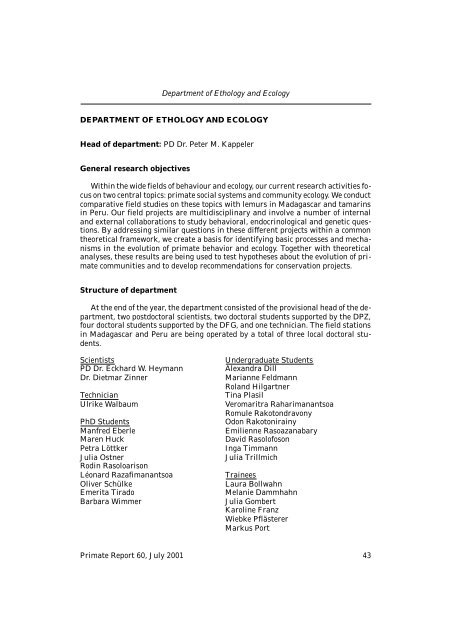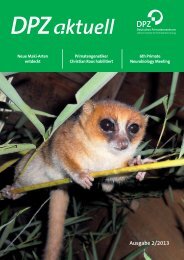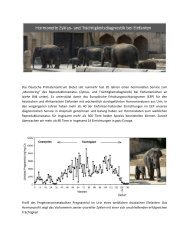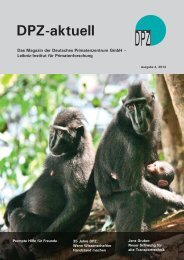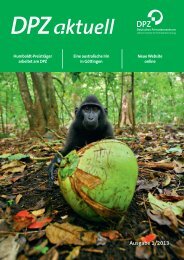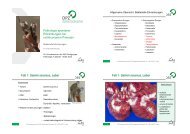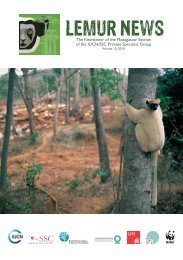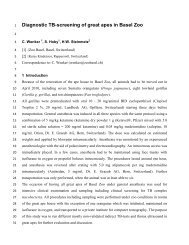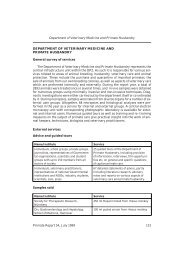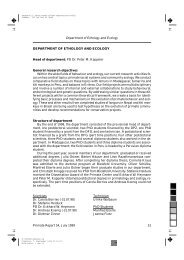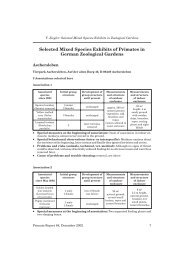DEPARTMENT OF ETHOLOGY AND ECOLOGY Head of ... - DPZ
DEPARTMENT OF ETHOLOGY AND ECOLOGY Head of ... - DPZ
DEPARTMENT OF ETHOLOGY AND ECOLOGY Head of ... - DPZ
Create successful ePaper yourself
Turn your PDF publications into a flip-book with our unique Google optimized e-Paper software.
<strong>DEPARTMENT</strong> <strong>OF</strong> <strong>ETHOLOGY</strong> <strong>AND</strong> <strong>ECOLOGY</strong><br />
<strong>Head</strong> <strong>of</strong> department: PD Dr. Peter M. Kappeler<br />
General research objectives<br />
Within the wide fields <strong>of</strong> behaviour and ecology, our current research activities focus<br />
on two central topics: primate social systems and community ecology. We conduct<br />
comparative field studies on these topics with lemurs in Madagascar and tamarins<br />
in Peru. Our field projects are multidisciplinary and involve a number <strong>of</strong> internal<br />
and external collaborations to study behavioral, endocrinological and genetic questions.<br />
By addressing similar questions in these different projects within a common<br />
theoretical framework, we create a basis for identifying basic processes and mechanisms<br />
in the evolution <strong>of</strong> primate behavior and ecology. Together with theoretical<br />
analyses, these results are being used to test hypotheses about the evolution <strong>of</strong> primate<br />
communities and to develop recommendations for conservation projects.<br />
Structure <strong>of</strong> department<br />
At the end <strong>of</strong> the year, the department consisted <strong>of</strong> the provisional head <strong>of</strong> the department,<br />
two postdoctoral scientists, two doctoral students supported by the <strong>DPZ</strong>,<br />
four doctoral students supported by the DFG, and one technician. The field stations<br />
in Madagascar and Peru are being operated by a total <strong>of</strong> three local doctoral students.<br />
Scientists<br />
PD Dr. Eckhard W. Heymann<br />
Dr. Dietmar Zinner<br />
Technician<br />
Ulrike Walbaum<br />
PhD Students<br />
Manfred Eberle<br />
Maren Huck<br />
Petra Löttker<br />
Julia Ostner<br />
Rodin Rasoloarison<br />
Léonard Razafimanantsoa<br />
Oliver Schülke<br />
Emerita Tirado<br />
Barbara Wimmer<br />
Department <strong>of</strong> Ethology and Ecology<br />
Undergraduate Students<br />
Alexandra Dill<br />
Marianne Feldmann<br />
Roland Hilgartner<br />
Tina Plasil<br />
Veromaritra Raharimanantsoa<br />
Romule Rakotondravony<br />
Odon Rakotonirainy<br />
Emilienne Rasoazanabary<br />
David Rasol<strong>of</strong>oson<br />
Inga Timmann<br />
Julia Trillmich<br />
Trainees<br />
Laura Bollwahn<br />
Melanie Dammhahn<br />
Julia Gombert<br />
Karoline Franz<br />
Wiebke Pflästerer<br />
Markus Port<br />
Primate Report 60, July 2001 43
Progress during the year<br />
Department <strong>of</strong> Ethology and Ecology<br />
The recommendations <strong>of</strong> the national scientific board with respect to this department<br />
still failed to be implemented in the previous year. Specifically, the position <strong>of</strong><br />
the head <strong>of</strong> our department remained vacant during the past year, so that the planning<br />
<strong>of</strong> field studies and the recruitment <strong>of</strong> students continue to be difficult. Moreover,<br />
the department continues to be handicapped in internal comparisons because<br />
<strong>of</strong> the continued discrepancy with respect to the resources available to other departments.<br />
Despite these difficulties, several scientific projects were completed and even<br />
initiated during the previous year. Dr. Rodin Rasoloarison provided the salient contribution<br />
with his thesis on the taxonomic revision <strong>of</strong> Malagasy mouse lemurs, which<br />
he defended with honors before the University <strong>of</strong> Antananarivo. In his thesis, he described<br />
several new primate species, which also attached a lot <strong>of</strong> public interest. Dr.<br />
Barbara Wimmer defended her PhD thesis, which consisted <strong>of</strong> a comparative study<br />
An artificial nesthole <strong>of</strong> grey<br />
mouse lemurs, fitted with an<br />
IR-video camera to study patterns<br />
<strong>of</strong> infant care.(Foto: M.<br />
Eberle).<br />
44 Primate Report 60, July 2001
Department <strong>of</strong> Ethology and Ecology<br />
<strong>of</strong> the population genetics <strong>of</strong> four polygynous lemur species, at the University <strong>of</strong> Munich.<br />
Moreover, the PhD thesis <strong>of</strong> Dr. Johanna Fietz was honored with a prize from<br />
the <strong>DPZ</strong>. Manfred Eberle, Julia Ostner, Léonard Razafimanantsoa and Oliver<br />
Schülke spent most <strong>of</strong> the past year collecting data for their thesis projects in<br />
Kirindy or the laboratories <strong>of</strong> the <strong>DPZ</strong>. Preparations for a new project on the genetic<br />
population structure <strong>of</strong> Lepilemur ruficaudatus in the Forêt de Kirindy were successful<br />
concluded by Dr. Dietmar Zinner. Thesis topics for master’s theses in the<br />
past year included infanticide avoidance, vigilance and olfactory behavior <strong>of</strong> redfronted<br />
lemurs, group movements in sifakas and competition between nocturnal lemurs.<br />
The results <strong>of</strong> the research activities at Kirindy during the two preceding years were<br />
presented and discussed during a symposium. Several Malagasy and European students<br />
were trained in tropical ecology, and Kirindy was used by students and researchers<br />
from Germany, England, Italy and the U.S..<br />
Research in Peru was mainly carried out within the framework <strong>of</strong> internal cooperations.<br />
Janna Kirchh<strong>of</strong> conducted first field work on the role <strong>of</strong> alarm calls in<br />
interspecific associations <strong>of</strong> tamarins for her dissertation. Towards the end <strong>of</strong> the<br />
year, Maren Huck and Petra Löttker started the field phase <strong>of</strong> the DFG-funded project<br />
on the proximate regulation and genetic consequences <strong>of</strong> the polyandric mating<br />
system <strong>of</strong> tamarins. The study on tamarin seed dispersal <strong>of</strong> the leguminose Parkia<br />
panurensis was finished with a diploma thesis. This thesis demonstrated that seed<br />
dispersal by tamarins influences the regeneration <strong>of</strong> this plant species in the study<br />
area. Recruitment success was higher around tamarin sleeping sites than under<br />
Parkia-parent trees. Apart from these projects, data collection on basic aspects <strong>of</strong> the<br />
feeding ecology and group dynamics <strong>of</strong> the tamarins and on the phenology <strong>of</strong> the<br />
15-20 m<br />
10-15 m<br />
5-10 m<br />
0-5 m<br />
Ground<br />
Saguinus fuscicollis<br />
Saguinus mystax<br />
0 10 20 30 40 50<br />
%<strong>of</strong>predation events<br />
A parameter <strong>of</strong> niche segregation between moustached tamarins (Saguinus mystax)<br />
and saddle-back tamarins (Saguinus fuscicollis) is the differential use <strong>of</strong> strata when<br />
searching for and capturing animal prey. This results in differences in the spectrum <strong>of</strong><br />
animal prey, which contributes to the reduction or avoidance <strong>of</strong> interspecific feeding<br />
competition.<br />
Primate Report 60, July 2001 45
Department <strong>of</strong> Ethology and Ecology<br />
study area was continued. Once again unexpected events happened in the tamarin<br />
groups, which emphasize the dynamics and flexibility <strong>of</strong> the social organisation and<br />
mating system <strong>of</strong> tamarins.<br />
The hamadryas baboon project in Eritrea had to be stopped for the time being in<br />
March 2000. Due to the ongoing war between Eritrea and Ethiopia the schedule <strong>of</strong><br />
the project had to be changed. The planned long-term observations <strong>of</strong> the baboons<br />
had to be cancelled and the participation <strong>of</strong> students in the project was not realized<br />
due to the risks. Despite the unfavorable conditions, several important questions in<br />
relation to the distribution, abundance and genetic population structure <strong>of</strong> hamadryas<br />
baboons in Eritrea could be studied successfully.<br />
Projects and partners in cooperation<br />
(I: interdepartmental projects, E: external cooperation; A: project completed, L: current<br />
project)<br />
Projects and Partners <strong>of</strong> the<br />
Department <strong>of</strong> Ethology and Ecology<br />
Conservation Biology <strong>of</strong> Malagasy lemurs and New World primates<br />
B. RAKOTOSAMIMANANA (Univ. Antananarivo, Madagascar),<br />
J.U. GANZHORN (Inst. <strong>of</strong> Zoology, Univ. Hamburg), S. GOODMAN (FMNH<br />
Chicago & WWF Madagascar), F. ENCARNACIÓN (Univ. Nacional Mayos<br />
San Marcos, Lima, Peru), H. VALDERRAMA FREYRE, R. PEZO (Univ.<br />
Nacional Amazonia Peruana, Iquitos, Peru), J.K. HODGES (Dept. <strong>of</strong> Reproductive<br />
Biology, <strong>DPZ</strong>), H. ZISCHLER (Working Group Primate Genetics,<br />
<strong>DPZ</strong>), P.M. KAPPELER, E.W. HEYMANN<br />
Population genetics <strong>of</strong> Lepilemur ruficaudatus in West-Madagascar<br />
D. ZINNER, R. HILGARTNER, P.M. KAPPELER, H. ZISCHLER<br />
(Working Group Primate Genetics, <strong>DPZ</strong>)<br />
Sexually selected traits in female primates<br />
D. ZINNER, C. NUNN (Univ. Virginia, VA, USA), C.P. van SCHAIK<br />
(Duke Univ., NC, USA), D. STAHL (Univ. St. Andrews, GB)<br />
Genetic population structure <strong>of</strong> baboons in Eritrea<br />
D. ZINNER, A. HAPKE, H. ZISCHLER (Working Group Primate Genetics,<br />
<strong>DPZ</strong>)<br />
E,I L<br />
I L<br />
E L<br />
I L<br />
Structure <strong>of</strong> neotropical primate communities<br />
E.W. HEYMANN, J.U. GANZHORN (Inst. <strong>of</strong> Zoology, Univ. Hamburg)<br />
Taxonomy and biogeography <strong>of</strong> Cheirogaleids<br />
E L<br />
R. RASOLOARISON, S. GOODMAN (FMNH Chicago & WWF Madagascar),<br />
A. YODER (Northwestern Univ., USA), J.U. GANZHORN (Inst.<br />
<strong>of</strong> Zoology, Univ. Hamburg), B. RAKOTOSAMIMANANA (Univ. Antananarivo,<br />
Madagascar), P.M. KAPPELER<br />
E L<br />
46 Primate Report 60, July 2001
Department <strong>of</strong> Ethology and Ecology<br />
Projects and Partners <strong>of</strong> the<br />
Department <strong>of</strong> Ethology and Ecology<br />
Feeding ecology and seed dispersal in sympatric tamarins<br />
A.C. SMITH (Univ. Stirling, GB), M. FELDMANN (Faculty <strong>of</strong> Biology,<br />
Univ. Göttingen), C. KNOGGE (Dept. <strong>of</strong> Veterinary Medicine and Primate<br />
Husbandry, <strong>DPZ</strong>), E. TIRADO, E.W. HEYMANN<br />
Adaptations <strong>of</strong> the visual system <strong>of</strong> diurnal and nocturnal<br />
primates<br />
L. PEICHL (MPI for Brain Research, Frankfurt), A. R<strong>AND</strong>RIANJAFY<br />
(Parc Botanique et Zoologique de Tsimbazaza, Madagascar),<br />
H.M. BUCHANAN-SMITH (Univ. Stirling, GB), N. MUNDY (Univ.<br />
Oxford, GB), P.M. KAPPELER, E.W. HEYMANN<br />
Genetic analysis <strong>of</strong> the mating system <strong>of</strong> polygynous lemurs<br />
D. TAUTZ (Univ. Köln), H. ZISCHLER (Working Group Primate Genetics,<br />
<strong>DPZ</strong>), M. EBERLE, O. SCHÜLKE, B. WIMMER, D. ZINNER,<br />
P.M. KAPPELER<br />
Sozio-endocrinology <strong>of</strong> group-living lemurs<br />
M. HEISTERMANN, J.K. HODGES (Dept. <strong>of</strong> Reproductive Biology, <strong>DPZ</strong>),<br />
J. OSTNER, P.M. KAPPELER<br />
Proximate regulation and genetic consequences <strong>of</strong> the mating<br />
system <strong>of</strong> polyandric tamarins<br />
M. HEISTERMANN, J.K. HODGES (Dept. <strong>of</strong> Reproductive Biology, <strong>DPZ</strong>),<br />
U.-R. BÖHLE, C. SCHWIEGK, H. ZISCHLER (Working Group Primate<br />
Genetics, <strong>DPZ</strong>), M. HUCK, P. LÖTTKER, E.W. HEYMANN<br />
Ecology <strong>of</strong> male-female relationships in hamadryas baboons in<br />
Eritrea<br />
D. ZINNER, F. PELÁEZ, (Univ. Autónoma Madrid, E), I. LEINFELDER,<br />
R. DELEU (Univ. Antwerp, RUCA, B), J. SHOSHANI (Dept. <strong>of</strong> Biology,<br />
Univ. Asmara, Eritrea)<br />
Comparative aspects <strong>of</strong> lemur socio-ecology<br />
B. RAKOTOSAMIMANANA, L. RAZAFIMANANTSOA, V. RAHARIMA-<br />
NANTSOA, R. RAKOTONDRAVONY, O. RAKOTONIRAINY, E. RASO-<br />
AZANABARY, D. RASOL<strong>OF</strong>OSON (Univ. Antananarivo, Madagascar),<br />
A. R<strong>AND</strong>RIANJAFY (Parc Botanique et Zoologique de Tsimbazaza,<br />
Madagascar), M. PERRET (MNHN, Laboratoire d'Ecologie, Brunoy, F),<br />
H. ERKERT (Univ. Tübingen), A. DILL, M. EBERLE, R. HILGARTNER,<br />
P.M. KAPPELER, J. OSTNER, T. PLASIL, O. SCHÜLKE, D. ZINNER<br />
Acoustic communication in lemurs and New World primates<br />
C. FICHTEL, J. KIRCHH<strong>OF</strong>, K. HAMMERSCHMIDT (Dept. <strong>of</strong> Neurobiology,<br />
<strong>DPZ</strong>), J. TRILLMICH, D. TODT (Inst. <strong>of</strong> Ethology, FU-Berlin),<br />
P.M. KAPPELER, E.W. HEYMANN<br />
E,I L<br />
E L<br />
E L<br />
I L<br />
I L<br />
E L<br />
E L<br />
E,I L<br />
Primate Report 60, July 2001 47
Projects and Partners <strong>of</strong> the<br />
Department <strong>of</strong> Ethology and Ecology<br />
Experimental study <strong>of</strong> infanticide risk in red-fronted lemurs<br />
(Eulemur fulvus rufus)<br />
T. PLASIL, H. LADICH (Inst. <strong>of</strong> Evolutionary Biology, Univ. Wien),<br />
C. FICHTEL (Dept. <strong>of</strong> Neurobiology, <strong>DPZ</strong>), P.M. KAPPELER<br />
E,I L<br />
Behavioural ecology and evolution <strong>of</strong> interspecific associations<br />
in callitrichines<br />
H.M. BUCHANAN-SMITH (Univ. Stirling, GB), E.W. HEYMANN<br />
Phylogeny <strong>of</strong> New World primates<br />
E L<br />
S. SINGER, H. ZISCHLER (Working Group Primate Genetics, <strong>DPZ</strong>),<br />
E.W. HEYMANN<br />
I L<br />
Scientific contributions<br />
Doctoral theses<br />
RASOLOARISON, R.: Taxonomy and biogeography <strong>of</strong> Microcebus spp. in the western<br />
portion <strong>of</strong> Madagascar. Département de Paléontologie et d’Anthropologie Biologique,<br />
University <strong>of</strong> Antananarivo, Madagascar (2000).<br />
WIMMER, B.: Study <strong>of</strong> the mating system and population structure <strong>of</strong> Mirza<br />
coquereli, Microcebus murinus, Eulemur fulvus rufus and Propithecus verreauxi<br />
verreauxi. Institute <strong>of</strong> Zoology, University <strong>of</strong> Munich (2000).<br />
Diploma theses<br />
Department <strong>of</strong> Ethology and Ecology<br />
DILL, A.: Aspects <strong>of</strong> infant care and development in sifakas (Propithecus verreauxi<br />
verreauxi, GR<strong>AND</strong>IDIER 1867, Primates: Indridae). Institute <strong>of</strong> Zoology, University<br />
<strong>of</strong> Würzburg (2000).<br />
FELDMANN, M.: Seed ecology <strong>of</strong> Parkiain the Amazon rainforest: Seed dispersal by<br />
tamarins (Callitrichidae), secondary seed dispersal, and seed predation. University<br />
Göttingen (2000).<br />
RAKOTONDRAVONY, R.: The locomotor behavior <strong>of</strong> female Propithecus verreauxi<br />
verreauxi (A. Grandidier, 1867) with and without infants. Département de Paléontologie<br />
et d’Anthropologie Biologique, University <strong>of</strong> Antananarivo, Madagascar<br />
(2000).<br />
TIMMANN, I.: Reciprocity <strong>of</strong> grooming in hamadryas baboons (Papio hamadryas)<br />
and the market value theory. University Hamburg (2000).<br />
48 Primate Report 60, July 2001
TRILLMICH, J.: The acoustic coordination <strong>of</strong> group movements in sifakas (Propithecus<br />
verreauxi). Free University Berlin (2000).<br />
Other contributions<br />
HEYMANN, E.W., CANAQUINY, J.E., ENCARNACIÓN C.F.: Report on a primate<br />
survey on the Río Curaray, northern Peruvian Amazonia. Report to the Margot<br />
Marsh Biodiversity Foundation.<br />
Congress contributions<br />
Department <strong>of</strong> Ethology and Ecology<br />
Tagung ZOO-Kunft 2000, Münster, 18.-20.02.00, HEYMANN, E.W.: Nahrungsökologie<br />
von Tamarinen und die Bedeutung für die Haltung in Gefangenschaft.<br />
13. Jahrestagung der Deutschen Gesellschaft für Tropenökologie (gtö) Jahrestagung,<br />
Würzburg, 01.-05.03.00,<br />
FELDMANN, M., HEYMANN, E.W.: Samenökologie von Parkia panurensis: bessere<br />
Überlebenschancen durch Ausbreitung.<br />
HEYMANN, E.W., KNOGGE, C., TIRADO HERRERA, E.R.: Vertebrate predation in<br />
sympatric tamarins, Saguinus mystax and Saguinus fuscicollis.<br />
KAPPELER, P.M., WIMMER, B., TAUTZ, D.: Populationsdynamik und -genetik von<br />
Propithecus verreauxi (Primates: Indridae).<br />
ZINNER, D., HAPKE, A.: Ecological comparison <strong>of</strong> primates in Eritrea.<br />
6 th Workshop <strong>of</strong> the European Marmoset Research Group (EMRG), "Inter-disciplinary<br />
Forum for Discussion and Training in Primate Biological & Biomedical Research",<br />
Paris, France, 02.-05.04.00, HEYMANN, E.W.: Feeding ecology <strong>of</strong> tamarins<br />
– (what) can we learn for captive husbandry?<br />
8 th International Behavioral Ecology Congress (ISBE), Zürich, Switzerland, 08.-<br />
12.08.00,<br />
OSTNER, J.: Why living with many males? Possible benefits for females from a high<br />
number <strong>of</strong> males in redfronted lemur groups in the Kiringy forest, Madagascar.<br />
SCHÜLKE, O.: Pairliving and male resource-defense monogamy in a nocturnal lemur?<br />
KAPPELER, P.M., WIMMER, B., TAUTZ, D.: Intrasexual selection in sifakas (Propithecus<br />
verreauxi, Indridae: Primates).<br />
Chemical Signals in Vertebrates IX, Symposium on "Ecological and Evolutionary<br />
Aspects <strong>of</strong> Chemical Communication", Krakau, PL, 26.-30.07.00, HEYMANN, E.W.:<br />
Scent marking, paternal care, and sexual selection in New World primates.<br />
3 rd International Symposium-Workshop on Frugivory and Seed Dispersal, São<br />
Pedro, Brazil, 06.-11.08.00, KNOGGE, C.: The efficacy <strong>of</strong> two sympatric tamarin species<br />
(Saguinus mystax, Saguinus fuscicollis) as seed dispersers.<br />
Primate Report 60, July 2001 49
Congreso Nacional de Psicobiología, PsicoB 2000, Oviedo, E, 15.-16.09.00, PELÁEZ,<br />
F., ZINNER, D., TORKLER, F.: Distribución y Hábitat de los Papiones Hamadryas<br />
(Papio h. hamadryas) en Eritrea.<br />
2 nd Göttinger Symposium „Primates in Biomedical Research: Diseases and Pathology“,<br />
Göttingen, 08.-09.11.00, HEYMANN, E.W.: Primate behavioural ecology and<br />
primate diseases: what`s in it for a future primatology?<br />
European Federation <strong>of</strong> Primatology (EFP) 2000 Meeting, London, GB, 28-29.11.00,<br />
OSTNER, J.: Why live with many males? The case <strong>of</strong> Eulemur fulvus rufus.<br />
SCHÜLKE, O.: Male resource-defense monogamy in a nocturnal lemur?<br />
93. Jahresversammlung, Deutsche Zoologische Gesellschaft, Bonn, 12.-15.06.00,<br />
KAPPELER, P.M., WIMMER, B., TAUTZ, D.: Genetic and social structure <strong>of</strong> a<br />
polygynous nocturnal lemur (Mirza coquereli, Primates: Cheirogaleidae).<br />
17. Ethologentreffen, Utrecht, NL, 15.-19.8.00, KAPPELER, P.M.: The evolution <strong>of</strong><br />
lemur social systems: facts and questions about non-convergence.<br />
Seminar lectures<br />
Project weeks <strong>of</strong> the Ernst-Abbé-Gymmasium, Eisenach, 19.01.00, HEYMANN,<br />
E.W.: Social organisation and mating systems <strong>of</strong> primates.<br />
Fachbereichstag FB Landschaftsnutzung und Naturschutz "GIS in der Planung",<br />
FH Eberswalde, 06.04.00, TORKLER, F., ZINNER, D.: Primaten in Eritrea: Verbreitung<br />
und Habitat.<br />
Faculty day <strong>of</strong> the Faculty Biology, Chemistry & Geosciences, Justus-Liebig-Universität<br />
Giessen, 14.06.00, HEYMANN, E.W.: Behavioural ecology <strong>of</strong> Amazonian<br />
tamarins.<br />
Other scientific activities<br />
Department <strong>of</strong> Ethology and Ecology<br />
• E.W. Heymann and D. Zinner are members <strong>of</strong> the IUCN/SSC Primate Specialist<br />
Group.<br />
E.W. Heymann<br />
• Member <strong>of</strong> the board <strong>of</strong> the Society for Tropical Ecology.<br />
• Member <strong>of</strong> the editorial board <strong>of</strong> Folia Primatologica.<br />
• Called to the editorial board <strong>of</strong> Neotropical Primates.<br />
• <strong>Head</strong>ed a round table discussion together with Dr. Colin Brown (Inveresk Research,<br />
Edinburgh, GB) on "Best Laboratory Practice" during the European Marmoset<br />
Research Group (EMRG) Workshop "Inter-disciplinary Forum for Discussion<br />
and Training in Primate Biological & Biomedical Research", Paris, F, 02.-<br />
05.04.00.<br />
• Organisation <strong>of</strong> the <strong>DPZ</strong>-Kolloquium in the winter term 2000/2001.<br />
50 Primate Report 60, July 2001
Department <strong>of</strong> Ethology and Ecology<br />
P.M. Kappeler<br />
• Associate editor <strong>of</strong> Behavioral Ecology and Sociobiology.<br />
• Scientific advisor to the German Academic Exchange Service (DAAD).<br />
Primate Report 60, July 2001 51


